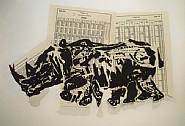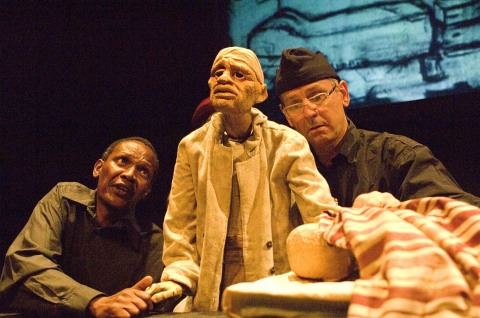It’s raining puppets. Hallelujah.
Hand puppets, shadow puppets, talking heads, rod-puppets, masks worn on the back of the head, real sardines, snowsuits that run, objects that come to life. The depth and breadth of materials that can be animated have been brought to life as part of the Walker’s Adventures in New Puppetry Series. And there is still more to come . . .
I was delighted to gobble up short puppet plays featuring mostly small-scale puppets at Open Eye Figure Theater last weekend for the Toy Theater Festival. So. Delicious.
The fare this evening was an entire play, George Buchner’s Woyzeck, reconfigured in South Africa as Woyzeck on the Highveld presented as a collaboration between Handspring Puppet Company and visual artist William Kentridge. And it is a visual and poetic feast.
A cast of five puppeteers moved gorgeous wooden puppets with grace and steady focus that managed to draw my eye without stopping me from engaging with the story told by the figures they operated. The puppets were sometimes so life-like they almost appeared to blink, in one scene a puppet breathed as it slept. The subtle, delicate moves of the puppets were matched by an appropriately melodramatic style of vocal delivery that kept me from melting in the beauty so much that I stopped thinking.
The world that the puppets inhabit in this production is equally absurd and crazy-making as the one Buchner envisioned in 1836, but it is not exactly same.
Woyzeck v.s. Woyzeck
It’s not necessary to know Buchner’s original work in order to digest this production. And because there were many additions, I was still left to wonder if the action would proceed in the way I expected, so if you do know the text, you still haven’t seen it all.
But here’s a bit-size bit of history about the play, just for fun:
Buchner was a talented and very young German playwright. He was only 25 when he died and at that time the script for Woyzeck was in fragments; it has been suggested that he intended to finish the play with a third act including a trial.
Though Buchner lived and died before existential writers like Albert Camus put pen to paper, the world Buchner invented has veins of similar absurdity. Like Sisyphus pushing a rock up a hill over and over, in the play, Woyzeck must eat a plate of green peas day after day after day. Buchner wanted to show how external forces act on the working-class protagonist to drive him insane.
Woyzeck at the Walker
Handspring and Kentridge have made changes to the script and moved the story to 1992 in South Africa. Words and relationships take on a different currency in the final year Apartheid was officially enforced. In this version, Woyzeck is a black servant to a white captain who still calls him ‘immoral’ though Woyzeck has done nothing wrong. His belongings include his South African ID card, Maria’s lover is now a miner.

The peas are mentioned, but are not a key part of Handspring’s production. Instead, Woyzeck’s madness is illustrated by Kentridge’s captivating, hand-drawn, shadowy animations along with sound effects that play as he is ‘studied’ and driven mad by a white doctor.
In Buchner’s Woyzeck, the characters visit a circus, in Handspring’s, a carnival barker steps out of his role as puppeteer to speak directly to the audience, reminding us of our spectatorship. Circus animals like horses and monkeys are replaced by an interlude with a stunning rhinoceros puppet who, like Handspring’s Woyzeck, appears to feel patronized by the tasks it must perform.

I am curious about reactions to the production. How do spectators feel about the only prominent female character Maria and her role? How does the end affect people? Why puppets? Do they help communicate Woyzeck’s alienation? Does watching puppets help the audience react to the story intellectually rather than react emotionally? Like Bucher’s original, the Handspring adaptation tells a tragic tale. How have stories of resistance and transformation from the same period in South Africa been theatricalized?
Your thoughts, please. . .
Get Walker Reader in your inbox. Sign up to receive first word about our original videos, commissioned essays, curatorial perspectives, and artist interviews.



)